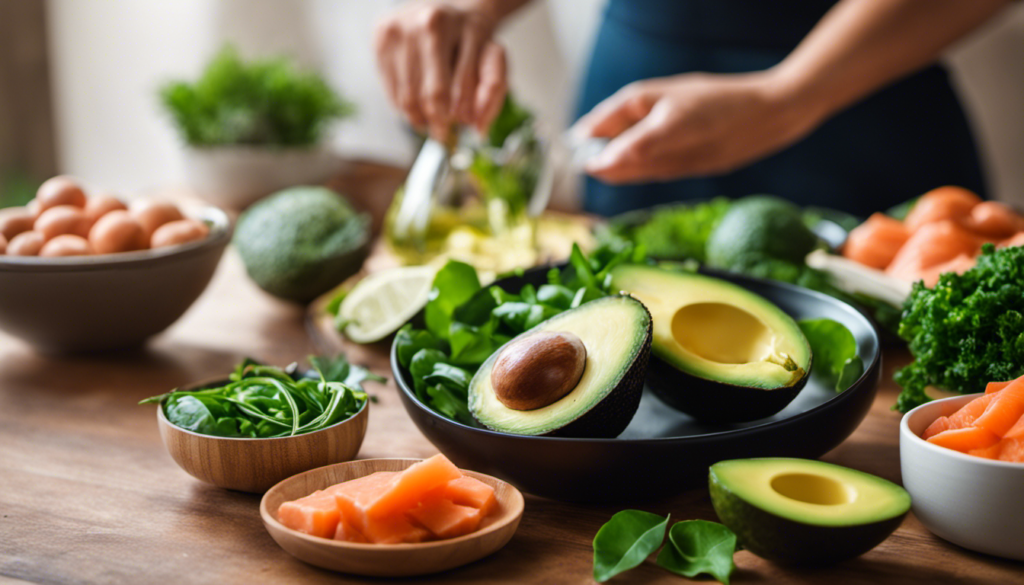Are you new to the keto diet and experiencing the dreaded keto flu? Don’t worry, we’ve got you covered.
In this article, we will provide expert advice on how to overcome the keto flu and make your transition to a low-carb lifestyle smoother. From understanding the symptoms to adjusting your diet, we’ll guide you every step of the way.
So, let’s dive in and learn how to support your body and feel your best on the keto journey.
Key Takeaways
- Keto flu is a temporary condition experienced during the transition to a ketogenic diet and typically lasts a few days to a week.
- Staying hydrated and maintaining electrolyte balance can help alleviate keto flu symptoms.
- Planning meals in advance and following appropriate macronutrient ratios (high fat, moderate protein, low carb) are crucial for a balanced ketogenic diet.
- Gradually reducing carbohydrate intake and slowly increasing fat intake can minimize the severity and duration of keto flu symptoms.
Understanding the Keto Flu
If you’re new to the keto diet, it’s important to understand the symptoms and causes of the keto flu.
The keto flu refers to a collection of symptoms that some people experience when they start the ketogenic diet. These symptoms can include fatigue, headache, nausea, dizziness, irritability, and difficulty concentrating.
The keto flu is often caused by the body’s adjustment to a low-carbohydrate, high-fat diet. When you restrict carbohydrates, your body enters a state of ketosis, where it starts using fat for fuel instead of glucose. This transition can cause temporary imbalances in electrolytes and dehydration, leading to the keto flu symptoms.
However, there are ways to manage the keto flu and make the transition smoother. One important step is ensuring proper hydration and electrolyte balance.
Hydration and Electrolyte Balance
Maintaining proper hydration and electrolyte balance is crucial for avoiding the symptoms of keto flu. When you embark on a ketogenic diet, your body goes through a transition phase where it adapts to using fat as its primary fuel source instead of carbohydrates. This transition can cause dehydration and electrolyte imbalances, leading to symptoms like fatigue, headaches, and muscle cramps.
To prevent this, here are three essential tips:
Increase your water intake: Drinking enough water is vital for staying hydrated and supporting your body’s functions. Aim for at least 8 cups of water per day.
Consider electrolyte supplementation: Since the ketogenic diet reduces water retention, it’s important to replenish electrolytes like sodium, potassium, and magnesium. You can achieve this by adding electrolyte supplements to your diet.
Consume electrolyte-rich foods: Incorporate foods like avocados, leafy greens, nuts, and seeds into your meals to naturally boost your electrolyte levels.
Gradual Carbohydrate Reduction
When transitioning to the keto diet, it’s recommended to slowly reduce your carbohydrate intake over time. This gradual reduction allows your body to adapt more easily to using fat for fuel instead of carbohydrates.
Slowly Transitioning to the Keto Diet
Transitioning to the keto diet slowly can help minimize the symptoms of keto flu. It’s important to give your body time to adjust to the new way of eating. Here are some transitioning tips to help you manage cravings and make the process easier for you:
- Gradually reduce your carbohydrate intake over a period of time.
- Focus on increasing your fat intake to keep you feeling satisfied and full.
By taking these steps, you can ease into the keto diet without feeling overwhelmed. It’s normal to experience cravings during the transition, but remember to stay committed to your goals and remind yourself of the benefits of the keto diet.
Now that you have learned how to transition slowly, the next section will discuss the importance of monitoring your carbohydrate intake. This will help you stay on track and ensure you are in ketosis.
Monitoring Carbohydrate Intake
To keep yourself on track and ensure you are in ketosis, it’s important for you to monitor your carbohydrate intake. Carbohydrate tracking or carb counting is a crucial aspect of the ketogenic diet. By keeping a close eye on your carb intake, you can stay within the recommended range and maintain a state of ketosis.
| Food Item | Carbohydrate Content |
|---|---|
| Avocado | 2 grams |
| Spinach | 1 gram |
| Almonds | 2 grams |
Tracking your carbohydrates can be made easier with the help of a food diary or mobile app. By recording your daily intake, you can ensure that you are not exceeding your carb limit. It’s important to note that the ideal carb intake for ketosis varies from person to person. Consulting with a healthcare professional or a registered dietitian can provide personalized guidance.
Increasing Healthy Fats
When it comes to increasing healthy fats in your diet, two excellent options to consider are coconut oil and avocado.
Incorporating coconut oil into your cooking can provide a rich source of medium-chain triglycerides (MCTs), which have been shown to have numerous health benefits.
Avocado, on the other hand, is a great source of monounsaturated fats, which are known for their heart-healthy properties.
When choosing sources of fat, it’s important to opt for high-quality sources, such as organic, cold-pressed coconut oil and ripe, fresh avocados, to ensure you’re getting the most nutritional value.
Incorporating Coconut Oil and Avocado
Incorporating coconut oil and avocado into your diet can help alleviate symptoms of keto flu. These two ingredients are not only delicious but also packed with health benefits. Here’s why you should consider adding them to your meals:
Coconut oil benefits:
Provides a quick source of energy due to its medium-chain triglycerides (MCTs)
Boosts metabolism and aids in weight loss
Supports brain function and improves cognitive performance
Helps reduce inflammation and supports a healthy immune system
Avocado recipes:
Try adding sliced avocado to salads or sandwiches for a creamy texture and healthy fats
Blend avocado into smoothies or use it as a base for creamy dressings and sauces
Make a delicious guacamole with avocados, lime juice, and spices
Use avocado as a replacement for butter or oil in baking recipes for a healthier twist
By incorporating these ingredients into your diet, you can enjoy their numerous health benefits while combating the keto flu.
Now, let’s explore how to choose quality sources of fat.
Choosing Quality Sources of Fat
Choosing quality sources of fat is essential for maintaining a healthy and balanced diet. When it comes to fats, it’s important to choose healthy oil options and practice portion control.
Healthy oils like olive oil, avocado oil, and coconut oil are rich in monounsaturated and polyunsaturated fats, which have been linked to numerous health benefits. These oils can be used for cooking, salad dressings, and even drizzling over roasted vegetables. However, it’s crucial to remember that even healthy fats should be consumed in moderation. Too much fat, even from healthy sources, can lead to weight gain and other health issues.
By practicing portion control and incorporating a variety of healthy oils into your diet, you can support your body with nutrient-rich foods that promote overall well-being.
Transitioning into the subsequent section about supporting your body with nutrient-rich foods, it’s important to explore other food groups that can provide essential vitamins and minerals.
Supporting Your Body with Nutrient-Rich Foods
Eating nutrient-rich foods can help support your body while overcoming keto flu. During this transition phase, it’s important to make sure you’re getting all the essential vitamins and minerals your body needs.
Incorporating a variety of colorful vegetables into your meals can provide a wide range of nutrients. Leafy greens like spinach and kale are rich in vitamins A, C, and K, as well as minerals like magnesium and potassium.
Protein sources are also important for repairing and building tissues. Opt for lean meats such as chicken, turkey, and fish, or plant-based options like tofu, tempeh, and legumes. These protein-rich foods can help replenish your energy levels and support your body as it adjusts to the ketogenic diet.
Remember to listen to your body and nourish it with wholesome, nutrient-dense foods.
Frequently Asked Questions
Can I still exercise while experiencing keto flu symptoms?
Yes, you can still exercise while experiencing keto flu symptoms. However, it’s important to listen to your body and take it easy if needed. Stay hydrated, replenish electrolytes, and rest when necessary to manage your symptoms effectively.
How long does the keto flu typically last?
The duration of the keto flu can vary, but it usually lasts about a week. To manage it, drink plenty of water, get enough electrolytes, eat nutrient-dense foods, and consider taking supplements like magnesium and potassium.
Can I take over-the-counter medications to alleviate keto flu symptoms?
Yes, you can take over-the-counter medications or supplements to alleviate keto flu symptoms. However, it’s important to consult with a healthcare professional and consider alternative remedies, as they may provide a more natural and holistic approach to relieving symptoms.
Is it normal to experience keto flu symptoms even after following the diet for a few weeks?
It is normal to experience keto flu symptoms even after following the diet for a few weeks. To prevent long-term effects, try increasing your intake of electrolytes and staying well hydrated.
Are there any specific foods that can worsen keto flu symptoms?
To alleviate keto flu symptoms, avoid foods high in carbohydrates like bread, pasta, and sugary snacks. Instead, focus on keto-friendly foods such as meats, fish, eggs, avocados, and leafy greens. Stay hydrated and consider adding electrolytes to your diet for relief.
Conclusion
Congratulations on taking the first steps towards a healthier lifestyle with the keto diet! Remember, the journey might not always be smooth sailing, but with the right strategies, you can overcome the keto flu.
By staying hydrated and maintaining electrolyte balance, you can minimize the symptoms and support your overall well-being. Gradually reducing carbohydrates and increasing healthy fats will help your body adjust to the new diet. Additionally, nourishing your body with nutrient-rich foods will provide the necessary vitamins and minerals.
So, don’t let the keto flu discourage you! Stay committed, stay informed, and soon you’ll be reaping the incredible benefits of this transformative diet.








